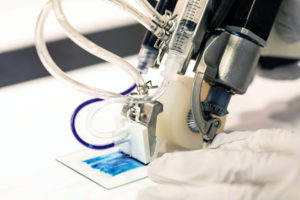
A study, led by Richard Cheng under the supervision of Axel Guenther, published in Biofabrication revealed that the 3D printer completed successful in-vivo trials on full-thickness wounds, according to a report in University of Toronto Engineering News. The researchers see the printer as an alternative to the current standard of care, which is skin grafting.
“Previously, we proved that we could deposit cells onto a burn, but there wasn’t any proof that there were any wound-healing benefits — now we’ve demonstrated that,” Guenther told University of Toronto Engineering News.
The printer is designed to cover wounds with a uniform sheet of biomaterial, stripe by stripe. The researchers constructed mesenchymal stroma cells (MSCs) into a “bio-ink” for the roller to release, helping to regenerate skin and reduce scarring, thanks to the differentiation of the MSCs into specialized cell types.
With the larger, full-body burns that the printer is designed to treat, there may not be enough healthy skin available, making the treatment more challenging, according to Ross Tilley Burn Centre (Toronto) director Dr. Marc Jeschke.
The latest design of the printer, which was initially unveiled in 2018, is earmarked to better treat larger wounds with a wheel that follows the track of a single-use microfluidic printhead, allowing for more control with wider wounds. Jeschke said he believes the printer could be in clinical settings within five years from now.
“Once it’s used in an operating room, I think this printer will be a game-changer in saving lives,” Jeschke said. “With a device like this, it could change the entirety of how we practice burn and trauma care.”

